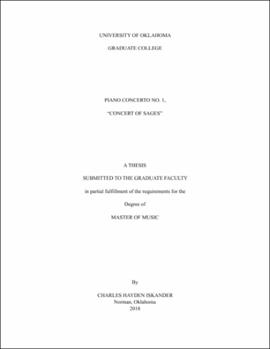| dc.description.abstract | Concert of Sages comes out of the duality of my being a composer and a pianist, and my desire to express this duality. As the orchestra is a prime test of a composers’ mettle, a concerto is a prime test of a concert soloist’s, and thus writing a piano concerto served as the ideal marriage of my dual studies. In addition, the concerto acts as a survey of both my compositional technique and orchestration.
The extramusical character of each movement comes through the thematic material and orchestration. “Sage of the Sky” is largely orchestrated in the upper register using high strings, high winds, high winds, and delicate percussion to create a windy atmosphere. Also contributing are the bright C lydian mode and jubilant 6/8 meter and irregular phrasing. “Sage of the Earth” contrasts the first movement with warmth and mellowness. This is expressed through the modality of F mixolydian, the use of earthier timbres from low winds and percussion, and more lush harmonic voicing. “Sage of Time” is the most mystical of the three movements, complete with unusual orchestral voicing and doubling throughout both the theme and its variations. In addition, the extramusical character of this movement is tied directly to its form, with each variation being a window into the life of this mystical chant.
Regarding technique, “Sage of the Sky” serves as a demonstration of compositional fundamentals. The movement explores sonata form — two contrasting themes, development, recap — as well as other elements like fugue procedure. It also demonstrates economy of structure, adapting these elements into a cohesive structure with just four and a half minutes of music. “Sage of the Earth” is in ternary form, and functions as a Romantic character piece for piano and orchestra. The primary exploration of this movement is melody: the outer sections are built on a principal theme, and the middle section is built on its inversion. “Sage of Time” is a theme and variations movement, written to explore compositional and developmental tools associated with that technique. The “chant” theme is subject to rhythmic modification, fragmentation, octave displacement, retrograde and counterpoint, and various combinations of the above. The movement also demands a higher level of pianism, with several variations and a cadenza bringing involved passagework and figurations. | en_US |
